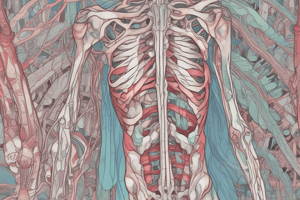Podcast
Questions and Answers
What is the approximate percentage of water in cartilage?
What is the approximate percentage of water in cartilage?
- 90-95%
- 40-50%
- 80-90%
- 65-80% (correct)
What is the main function of fibrocartilage in joints?
What is the main function of fibrocartilage in joints?
- To provide lubrication
- To provide structural support
- To facilitate bone growth
- To act as a cushion and manage compression forces (correct)
What is the primary component of the extracellular matrix in cartilage?
What is the primary component of the extracellular matrix in cartilage?
- Collagen (correct)
- Glycoproteins
- Proteoglycans
- Water
What type of cartilage is found in the auricle of the ear and the external auditory meatus?
What type of cartilage is found in the auricle of the ear and the external auditory meatus?
What is the purpose of the perichondrium in cartilage?
What is the purpose of the perichondrium in cartilage?
Where is hyaline cartilage primarily found in adults?
Where is hyaline cartilage primarily found in adults?
What is the term for the cavities in the matrix where cartilage cells or chondrocytes are contained?
What is the term for the cavities in the matrix where cartilage cells or chondrocytes are contained?
What happens to hyaline cartilage and fibrocartilage in later life?
What happens to hyaline cartilage and fibrocartilage in later life?
Study Notes
Cartilage Structure
- Cartilage is a tough but flexible tissue that makes up the main type of connective tissue in the body.
- It is composed of 65-80% water, which decreases with age, and a gel-like substance called the matrix.
- The matrix gives cartilage its form and function, providing firmness and resilience.
Perichondrium
- The perichondrium is a dense layer of fibrous connective tissue that covers many types of cartilage in the body.
Cartilage Composition
- Cartilage is made up of a dense extracellular matrix (ECM) with a sparse distribution of highly specialized cells called chondrocytes.
- The ECM is primarily composed of water, collagen, and proteoglycans, with other non-collagenous proteins and glycoproteins present in lesser amounts.
Types of Cartilage
- There are three types of cartilage: hyaline, fibrocartilage, and elastic cartilage.
Hyaline Cartilage
- Hyaline cartilage has a high proportion of amorphous matrix.
- It is the most widespread type and plays an important part in the growth in length of long bones.
- It is slippery and smooth, helping bones move smoothly past each other in joints.
- It is flexible but strong enough to help joints hold their shape.
- Locations: articular surfaces of movable joints, walls of respiratory tracts, costal cartilages, and epiphyseal plates of long bones.
Fibrocartilage
- Fibrocartilage has many collagen fibers embedded in a small amount of matrix.
- It is found in the discs within joints (e.g. temporomandibular joint and knee joint) and on the articular surfaces of the clavicle and mandible.
- Its main function is to act as a cushion within joints, managing compression forces and reducing stress on joints.
- Locations: secondary cartilaginous joints (e.g. pubic symphysis, annulus fibrosis of intervertebral discs), medial and lateral menisci of the knee joint, and locations where tendons and ligaments attach to bone.
Elastic Cartilage
- Elastic cartilage possesses large numbers of elastic fibers embedded in matrix.
- It is flexible and found in the auricle of the ear, external auditory meatus, auditory tube, and epiglottis, and tip of the nose.
Calcification and Ossification
- Hyaline cartilage and fibrocartilage tend to calcify or even ossify in later life.
Studying That Suits You
Use AI to generate personalized quizzes and flashcards to suit your learning preferences.
Description
Learn about the structure and composition of cartilage, including its water content, matrix, and perichondrium layer.




